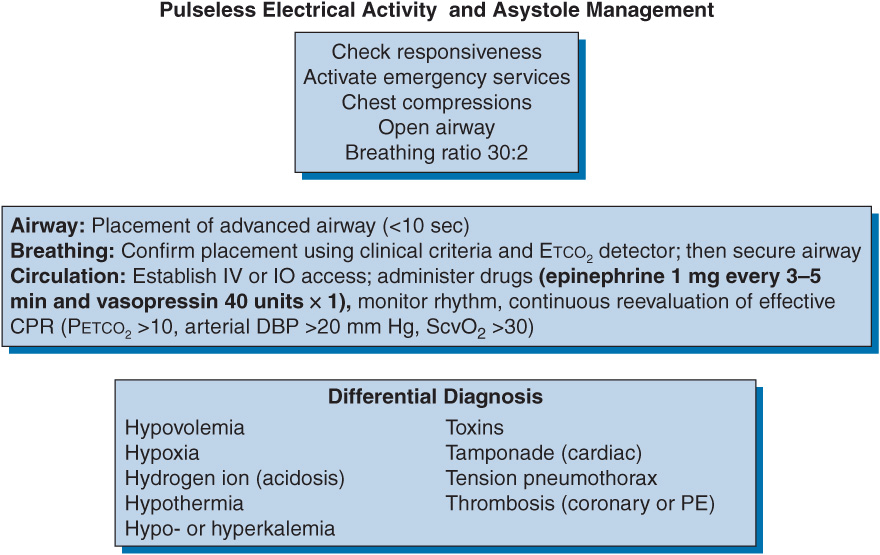Data from The American Heart Association BLS and ACLS Guidelines 2010 for cardiopulmonary resuscitation and emergency cardiovascular care. Circulation 2010:122;S729–S767.
Pulseless Electrical Activity and Asystole
Causes: Hs and Ts. Hypoxia, hypovolemia, hypo- or hyperkalemia, hydrogen ion (acidosis), thrombosis (pulmonary embolism [PE] or myocardial infarction [MI]), tension pneumothorax, toxins (drug overdose), tamponade (cardiac). Note that hypoglycemia no longer included in Hs but nonetheless should still be included in the differential diagnosis.
Clinical manifestations: Usually begins as another rhythm such as bradycardia or VT or VF with progression to pulseless electrical activity (PEA) or asystole.
Diagnosis: PEA is any rhythm other than VT or VF without a palpable pulse. Asystole is the absence of any electrical cardiac activity in the myocardium.
Management: The 2010 American Heart Association (AHA) recommendations advise starting chest compressions immediately without checking for a pulse or respirations in an unresponsive patient. Better outcomes are associated with early chest compressions, quality of chest compressions (sternal depression of 1½–2 in (4–5 cm) in adults or 1–1½ in (2–4 cm) in children and then allowing for full reexpansion of the chest wall) and decreased time between intervals in chest compressions. If the provider is alone, he or she should give 30 compressions for every 2 breaths. If an advanced airway or bag-mask is used with another rescuer assisting, respirations should target 10 to 12 breaths/min. Atropine is no longer included in the 2010 AHA guidelines for PEA or asystole. Defibrillation is not recommended in PEA or asystole. After initial Basic Life Support (BLS) with chest compressions and assisted ventilation, the patient should receive epinephrine 1 mg IV every 3 to 5 minutes. Vasopressin 40 units IV can be substituted one time only for a dose of epinephrine. A pulse check and analysis of rhythm should be performed after 5 cycles of 30:2 compressions to breaths. The resulting rhythm and presence or absence of pulse will determine the next step in care. Any patient who requires ACLS intervention and survives should immediately be transferred to an intensive care unit for further workup, monitoring, and treatment.
CPR, cardiopulmonary resuscitation; DBP, diastolic blood pressure; ETCO2, end-tidal carbon dioxide; IO, intraosseous; IV, intravenous; PE, pulmonary embolism; PETCO2, partial pressure of end-tidal carbon dioxide; ScvO2, central venous oxygen saturation.
Pulseless Ventricular Tachycardia and Ventricular Fibrillation
Causes: Hs and Ts. Hypoxia, hypovolemia, hypo- or hyperkalemia, hydrogen ion (acidosis), thrombosis (PE or MI), tension pneumothorax, toxins (drug overdose), tamponade (cardiac)
Clinical manifestations: If a patient has progressed to pulseless VT or VF, he or she is most likely to be unresponsive and, of course, is at the extreme of hemodynamic instability because he or she does not have a pulse or blood pressure.
Diagnosis: The health care provider makes the assumption that all unmonitored cardiac arrests in adults are caused by VT or VF. VT or VF on an ECG is seen as wide complex ventricular tachycardia.
Treatment: BLS is initiated according to the most recent AHA 2010 guidelines. The time to defibrillation from collapse is the top determinant of survival. After the defibrillator pads are attached to the chest, the initial shock (120–200 J) is given. CPR is resumed. Epinephrine 1-mg IV bolus is the first medication and can be repeated every 3 to 5 minutes. After 2 minutes of CPR, the rhythm is analyzed. If VT or VF persists, another shock (≥initial shock energy) is given, and CPR is resumed for another 2 minutes. Amiodarone 300-mg IV bolus is provided next if VT or VF remains unresolved (subsequent dosing is 150-mg IV bolus). Notably, vasopressin 40-unit IV bolus can be substituted for the first or second dose of epinephrine. This cycle is repeated until another rhythm is identified or efforts have been exhausted. During the code, the Hs and Ts should be discussed, and treatment should be instituted (e.g., if the patient has a pneumothorax, chest tube placement is necessary; if the patient is hypovolemic, fluid boluses should be administered). High quality CPR should be continuously reevaluated throughout the code.
Stay updated, free articles. Join our Telegram channel

Full access? Get Clinical Tree





